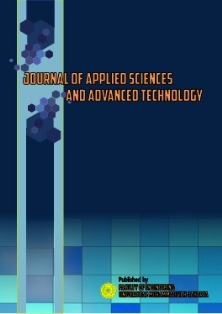Hardness Analysis of Bearing on Heat Treatment Process
DOI:
https://doi.org/10.24853/jasat.2.3.59-64Keywords:
Bearing, Heat treatment, Inner ring, Outer ring, Rockwell hardnessAbstract
Bearing is a mechanical element that resembles a loaded shaft, so that rotation or back and forth motion can be smooth, safe and long lasting. Bearings should be sturdy and durable to allow the shaft and other machine elements to work properly. If the bearing is not working properly then the performance of the whole system will decline or not work properly. For this reason, materials from high-carbon steel bearings should be durable and durable. To obtain the desired properties of the metal, the Heat Treatment process, especially the outer and inner ring, is used. Hardness testing of the outer and inner ring of the bearing is performed after the Heat Treatment process. Testing the violence using the Digital Rockwell Hardness Tester, the value of the violence can be read directly on the scale of the tool. The Heat Treatment process of the outer and inner ring of the bearing can produce the mechanical properties that the manufacturer wants, namely Rockwell hardness 62-64 HRC. If the result of the hardness test is in accordance with the factory standard, then the outer and inner ring meet the manufacturer's quality requirements.Downloads
References
Harish, S., Bensely, A., Lal, D. M., Rajadurai, A., & Lenkey, G. B. (2009). Microstructural study of cryogenically treated En 31 bearing steel. Journal of materials processing technology, 209(7), 3351-3357.
Mason, P. W., & Prevey, P. S. (2001). Iterative Taguchi Analysis: optimizing the austenite content and hardness in 52100 steel. Journal of Materials Engineering and performance, 10(1), 14-21.
Szost, B. A., Vegter, R. H., & Rivera-Díaz-del-Castillo, P. E. J. (2013). Developing bearing steels combining hydrogen resistance and improved hardness. Materials & Design, 43, 499-506.
Barka, N., Chebak, A., & Brousseau, J. (2011). Optimization of hardness profile of bearing seating heated by induction process using axisymmetric simulation. Piers Online, 7(4), 316-320.
Lesyk, D. A., Martinez, S., Mordyuk, B. N., Dzhemelinskyi, V. V., Lamikiz, A., Prokopenko, G. I., ... & Tkachenko, I. V. (2018). Laser-hardened and ultrasonically peened surface layers on tool steel AISI D2: correlation of the bearing curves’ parameters, hardness and wear. Journal of Materials Engineering and Performance, 27(2), 764-776.
Fabian, P., Jankejech, P., & Kyselova, M. (2014). Simulation of roundness, hardness and microstructure of bearing rings with thin cross sections by using SYSWELD. Communications-Scientific letters of the University of Zilina, 16(3A), 124-129.
Pan, J., Li, Y., & Li, D. (2002). The application of computer simulation in the heat-treatment process of a large-scale bearing roller. Journal of materials processing technology, 122(2-3), 241-248.
Kumar, S., & Rakesh Kumar, S. A. (2016). Optimization of heat treatment processes of steel used in automotive bearings. International Journal of Technical Research & Applications, 4, 38-44.
Hua, J., Shivpuri, R., Cheng, X., Bedekar, V., Matsumoto, Y., Hashimoto, F., & Watkins, T. R. (2005). Effect of feed rate, workpiece hardness and cutting edge on subsurface residual stress in the hard turning of bearing steel using chamfer+ hone cutting edge geometry. Materials Science and Engineering: A, 394(1-2), 238-248.
ZHAO, L. P., ZHANG, H. M., LU, L. W., & WANG, H. Y. (2009). Effect of heat treatment processes on microstructure and hardness of GCr18Mo steel [J]. Journal of Inner Mongolia University of Science and Technology, 1.
Diniardi, E., Nelfiyanti, N., Mahmud, K. H., Basri, H., & Ramadhan, A. I. (2019). Analysis of the Tensile Strength of Composite Material from Fiber Bags. Journal of Applied Sciences and Advanced Technology, 2(2), 39-48.
Gunduz, G., Korkut, S., Aydemir, D., & Bekar, Í. (2009). The density, compression strength and surface hardness of heat treated hornbeam (Carpinus betulus L.) wood. Maderas. Ciencia y tecnología, 11(1), 61-70.
Rahardja, I. B., Rikman, R., & Ramadhan, A. I. (2018). Analysis of Heat Transfer of Fiber Mesocarp of Palm Oil (Elaeis Guineensis Jacq) as Roof Building. Journal of Applied Sciences and Advanced Technology, 1(1), 1-8.
Diniardi, E., Ramadhan, A. I., Mubarok, R., & Basri, H. (2015). Analysis of mechanical properties connecting rod bolts outboard motor FT50CEHD. International Journal of Applied Science and Engineering Research, 4(5), 665-670.
Umbrello, D., Hua, J., & Shivpuri, R. (2004). Hardness-based flow stress and fracture models for numerical simulation of hard machining AISI 52100 bearing steel. Materials Science and Engineering: A, 374(1-2), 90-100.
Chinn, R. E. (2009). Hardness, bearings, and the Rockwells. Advanced Materials & Processes, 167(10), 29-31.
Krishna, S. C., Gangwar, N. K., Jha, A. K., Pant, B., & George, K. M. (2015). Effect of heat treatment on the microstructure and hardness of 17Cr-0.17 N-0.43 C-1.7 Mo martensitic stainless steel. Journal of Materials Engineering and Performance, 24(4), 1656-1662.
Tucho, W. M., Cuvillier, P., Sjolyst-Kverneland, A., & Hansen, V. (2017). Microstructure and hardness studies of Inconel 718 manufactured by selective laser melting before and after solution heat treatment. Materials Science and Engineering: A, 689, 220-232.
Fouad, H., Mourad, A. H., & Barton, D. C. (2005). Effect of pre-heat treatment on the static and dynamic thermo-mechanical properties of ultra-high molecular weight polyethylene. Polymer Testing, 24(5), 549-556.
Klecka, M. A., Subhash, G., & Arakere, N. K. (2011). Determination of subsurface hardness gradients in plastically graded materials via surface indentation. Journal of tribology, 133(3).
Min, Y. A., Quan, Z. H. O. U., Yi, L. U. O., Dan, L. I., & Wu, X. C. (2012). Tempering process to improve hardness uniformity of plastic mould steel. Journal of Iron and Steel Research, International, 19(12), 53-58.
Diniardi, E., Ramadhan, A. I., & Basri, H. (2014). Analisis Kekuatan Mekanik Dan Struktur Mikro Pada Material Polimer Penyusun Kipas Radiator. Jurnal Teknologi, 6(1), 55-67.
Yakub, A., Karmiadji, D. W., & Ramadhan, A. I. (2016). Optimasi Desain Rangka Sepeda Berbahan Baku Komposit Berbasis Metode Anova. Jurnal Teknologi, 8(1), 17-22.
Downloads
Published
Issue
Section
License
COPYRIGHT POLICY
The author(s) of an article published in the Journal of Applied Sciences and Advanced Technology (JASAT) retains ownership of the intellectual property rights in work (s).
PUBLISHING RIGHTS
The author(s) of an article published in the Journal of Applied Sciences and Advanced Technology (JASAT) have unrestricted publication rights. The authors give the Journal of Applied Sciences and Advanced Technology (JASAT) the right to publish the article and designate the Faculty of Engineering Universitas Muhammadiyah Jakarta Publishing as the original publisher of the article.
LICENSING POLICY
JASAT is an open-access journal that follows the Creative Commons Non-Commercial 4.0 International License (CC BY-NC 4.0), which states that:

Under this license, the reusers must give appropriate credit, provide a link to the license, and indicate if changes were made. Users may do so in any reasonable manner, but not in any way that suggests the licensor endorses users or their use.
Please take the time to read the whole license agreement (https://creativecommons.org/licenses/by-nc/4.0/). As long as reusers follow the license conditions, the owner cannot withdraw these freedoms. The following components are included under this license:
 Attribution: Users must provide appropriate attribution, including a link to the license, and indicate whether or not they made any modifications. Users are free to do so reasonably, but not in a manner that indicates the licensee approves of their usage.
Attribution: Users must provide appropriate attribution, including a link to the license, and indicate whether or not they made any modifications. Users are free to do so reasonably, but not in a manner that indicates the licensee approves of their usage.
 NonCommercial: Users may not use the material for commercial purposes.
NonCommercial: Users may not use the material for commercial purposes.












_2.png)


1.png)

2.png)
